In recent years, the ketogenic diet – a special form of low-carb nutrition – has regained popularity in endurance sports. More and more athletes are using it to train fat metabolism and reduce carbohydrate dependence during prolonged exertion. The idea behind it: If the body learns to utilize fat more efficiently, endurance performance can be maintained even without a constant supply of carbohydrates.
But what do scientific data truly say about the effectiveness of this dietary approach?
Can the Ketogenic Diet Actually Improve Performance – or Does it Even Restrict the Body During Intense Exertion?
What is the Ketogenic Diet?
The ketogenic diet is a special form of the Low-Carb-High-Fat (LCHF) diet. Its goal is to drastically reduce carbohydrate intake and significantly increase the fat content of the diet, in order to prompt the body to utilize ketone bodies as an alternative energy source. (1).
The classic ketogenic diet consists of a ratio of 3 to 4:1 of dietary fat to carbohydrates and protein (2). Depending on the study, diets are then defined as ketogenic diets if the proportion of carbohydrates is less than 5% (3) – or between 5 and 10% (4) – of the total energy. This corresponds to a carbohydrate intake of 30-50g per day – but only for people with low to moderate activity (5). Ambitious endurance athletes consume between 4,000 – 6,000 calories per day. If 5% of the energy intake comes from carbohydrates, this would correspond to 50-75g of carbs.
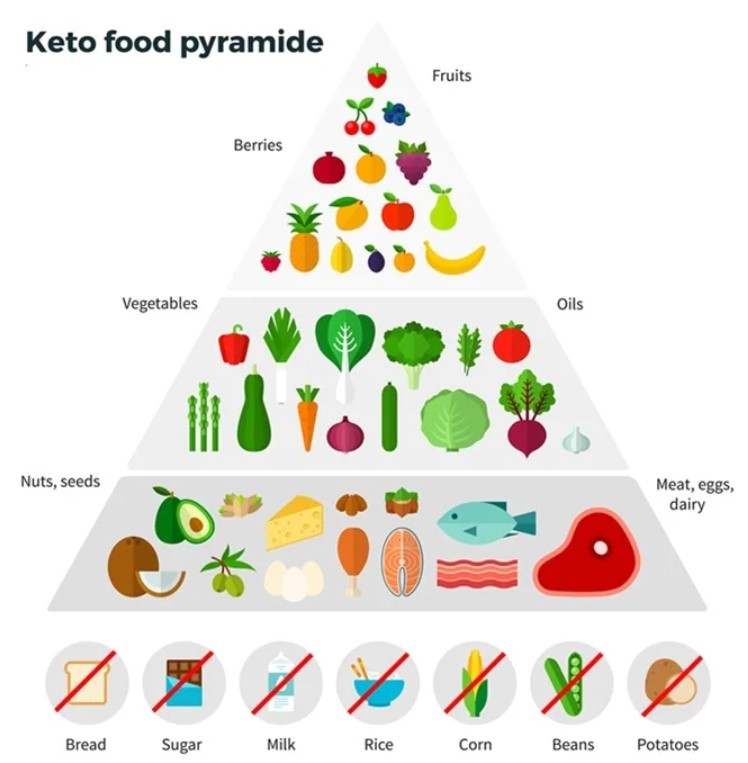
Keto-Adaptation: when Metabolism Shifts
The consistent implementation of a ketogenic diet shifts energy metabolism towards increased fat oxidation while simultaneously reducing glucose utilization. This process, known as keto-adaptation, is considered a central mechanism for applying this dietary approach in sports (6).
The ketone bodies can be used as an energy source by both the brain and the muscles. But are they more effective than carbohydrates?
In a state of ketosis, the body increasingly produces ketone bodies — primarily acetone, acetoacetate, and beta-hydroxybutyrate (βHB). βHB serves as the main measure for the degree of ketosis, with a value above 0.5 mmol/L in the blood indicating what is known as nutritional ketosis (7).
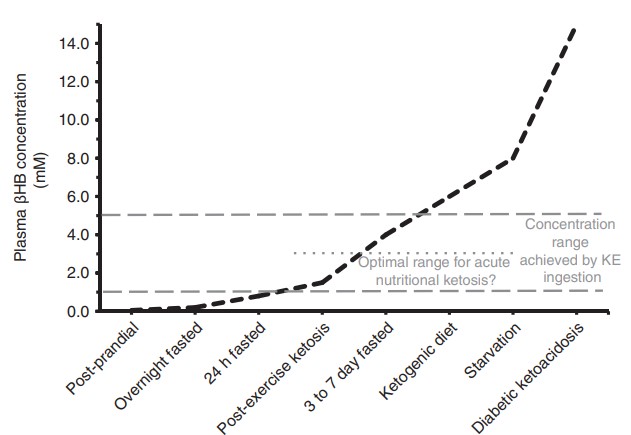
Ketone concentration in different nutritional situations (7)
Theoretically, in this metabolic state, the body is supposed to become so efficient in fat and ketone utilization that the same performance can be achieved without continuously supplying carbohydrates during training or competition (8).
Ketogenic Diet in Endurance Sports: Potentials and Limitations
Limited Energy Reserves
Proponents of the ketogenic diet argue that the limited carbohydrate stores in the body could represent a central weakness during prolonged endurance activities (9, 10, 11). In the body, carbohydrates are primarily stored as glycogen in muscles (250–600 g) and liver (90 g); additionally, approximately 30 g of glucose are available in the blood – totaling around 1000–2400 kcal. However, even a partial depletion of these stores can lead to a reduction in performance.
In contrast, the body – even with a low body fat percentage – possesses enormous fat reserves: A 70 kg person with 10% body fat carries approximately 49,000 kcal of stored energy. This explains why the idea of targeted fat metabolism improvement is fundamentally attractive to many athletes (12).
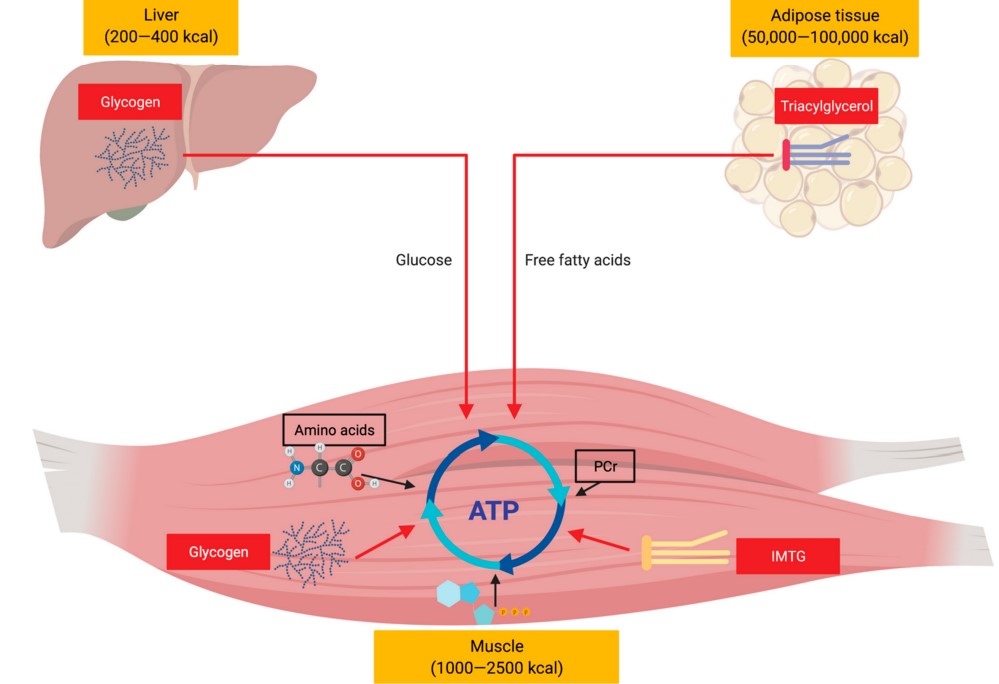
Simplified illustration of energy sources in endurance sports (13)
Digestive Problems
Due to the constant consumption of carbohydrates, nutrients are diverted from the stressed muscles to the intestines to support digestion, which can lead to reduced training economy and digestive disorders (14). In addition, humans can only absorb limited amounts of glucose and fructose per hour via the SGLT1 and GLUT-2, as well as GLUT5 transporters in the small intestine. Higher amounts of carbohydrates can lead to a ‘backlog’ of sugar molecules in the intestine, which can lead to gastrointestinal problems – such as diarrhea (15).
And Indeed, Digestive Problems are Very Common among Endurance Athletes:
- An online survey of long-distance runners from 2008 showed a prevalence of 45% among 1,281 athletes (16)
- Digestive problems occur in up to 93% of participants in Ironman triathlon athletes (17)
- A smaller study found gastrointestinal complaints in 9 of 15 ultramarathon runners: including nausea (89%), abdominal cramps (44%), diarrhea (44%), and vomiting (22%) (1, 8)
- However, not all digestive problems are due to nutritional strategies (19)
- There are also very large differences in the frequency and severity of the problems that occur depending on the sport, as well as strong individual differences between individual athletes in the endurance area
Against this Background, the Question Arises whether the Ketogenic Diet could Represent an Advantageous Alternative?
After adapting to the ketogenic diet, the body should be able to use fat more effectively for energy production. This would be advantageous because, in contrast to the limited carbohydrate stores, the body has very large energy stores in the form of body fat. Even in a person with a low body fat percentage of approximately 10%, this would still represent an energy reserve of approximately 49,000kcal (in a 70kg person).
The idea is that a well-trained fat metabolism can produce energy quickly enough in the sub-maximal range and is not dependent on a high carbohydrate intake during exercise, which in turn should make most gastrointestinal problems disappear.
Changes in Substrate Metabolism
Several studies show that a ketogenic diet can indeed induce a metabolic adaptation favoring fat oxidation:
In a pilot study, Kreutzer et al. (2003) observed increased fat and decreased carbohydrate oxidation during a 30-km cycling test (20). Prins et al. found in a 5 km time trial (running against the clock) that with a high-carbohydrate diet, 3-7% of the energy was obtained from fat and 93-97% from carbohydrates. With a ketogenic intervention, however, the energy supply was 36-52% fat and 48-64% carbohydrates (21).
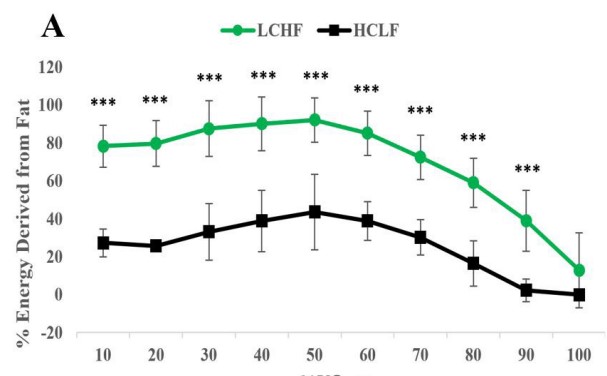
Percentage of energy supply through fatty acids: low-carb high-fat vs. high-carb low-fat (21)
Maximum fat oxidation was also significantly higher in the ketogenic diet group than in the carb group. At an exercise intensity of 60% of VO2max, fat oxidation in the keto group was even 117% higher at 1.15 g/min than in the high-carb group (0.51 g/min) (21).
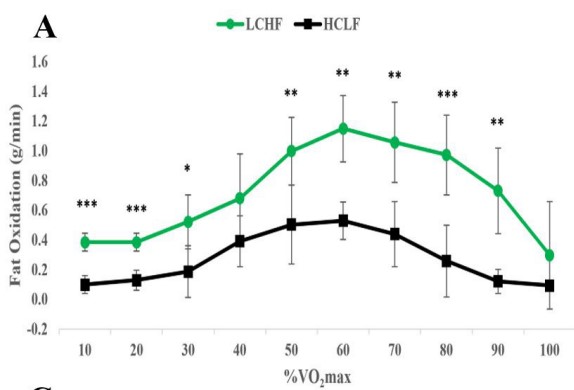
Fat oxidation rate in low-carb (green) vs high-carb (black) (21)
Other studies have confirmed this observation of a shift towards increased fat oxidation and reduced carbohydrate oxidation (22). Furthermore, a higher concentration of key enzymes (β-hydroxyacyl-CoA-dehydrogenase) of fat metabolism was also observed (23), as well as a stronger activation of signalling proteins that lead to increased mitochondrial biogenesis (24). These are important physiological processes for aerobic energy supply and could lead to improved performance in endurance athletes in the long term.
How Does the Ketogenic Diet Affect Athletic Performance?
The research on ketogenic diets and their effect on the performance of endurance athletes is very inconsistent. The studies differ greatly in their design—for example, about the participating athletes, the training conditions, and the test protocols—and also in their quality. Many studies include only a few participants, and numerous subjects often drop out of the study prematurely or do not adhere consistently to the guidelines. This suggests that a ketogenic diet is difficult for many people to implement in practice in the long term.
Positive Effects on Performance
In fact, to our knowledge, there is currently only 1 study (25) in which a ketogenic diet has led to an improvement in performance – compared to a conventional sports diet with many carbohydrates:
Lamberts et al. (1994) found a significantly better performance after a 2-week ketogenic diet: In the test protocol, the resistance was increased by 25 watts every 150 s until the specified power could no longer be maintained (25). Here, the subjects were able to maintain the performance requirement significantly longer if they adhered to a ketogenic diet.
- keto: 79.7 ± 7.9 min held out
- high-carb: 42.5 ± 7 min held out
In a high-intensity Wingate test (30s all out on the bicycle ergometer), however, there were no differences in performance in the study. In another study by the same duo of authors (26), the effect of a 2-week ketogenic diet—followed by a 3-day refeed with carbohydrates—on cycling performance was tested. In the test (150 min at 70% of VO2-max, followed by a 20 km time-trial), the group that had previously followed a ketogenic diet performed better (29.5 min fast vs. 30.9 min fast).
However, only 5 cyclists participated in both studies, so it is questionable to what extent these results are meaningful for the general public.
In addition, two studies observed an increase in VO2 max* after consuming a ketogenic diet. However, the VO2 max increased just as much as in the other groups in which many carbohydrates were consumed. So there was no relative improvement compared to the high-carb group, but only no deterioration.
*VO2 max is the maximum amount of oxygen (in milliliters) that is consumed per minute and per kilogram of body weight at maximum performance. This value is an indicator of aerobic fitness and should increase with increasing fitness.
Interestingly, both studies were conducted with elite race walkers who chose their own nutritional intervention, and the athletes who chose the ketogenic diet already had slightly higher average VO2 max values at the beginning of the intervention (27). This suggests that other factors may have simultaneously influenced the choice of diet and the aerobic capacity of athletes, such as genetic variations.
Improved Fat Metabolism, but Reduced Intensity Performance
Numerous studies confirm that the ketogenic diet significantly improves the fat metabolism of athletes (25, 26, 27). However, a clear disadvantage also emerges: the ability to access carbohydrates as the primary energy source at higher intensities is limited. Most studies have shown an impairment of performance, as well as a deterioration of VO 2 max values found (28).
🧠 Want to learn more about training fat metabolism?
Then listen to our podcast episode on the topic, where we discuss current study results, practical examples, and coaching experiences.
🎙️click here for the podcast episode ➜ “Training Fat Metabolism”
Time to Exhaustion (TTE)
The study by Burke et al. (2017) impressively demonstrated this: After three weeks of a ketogenic diet, the fat metabolism markers of the athletes improved significantly, but the efficiency during intense exercise decreased by about 5–8% (29).
The “time to exhaustion” study design is not a performance test relevant in practice. It is NOT about athletes Getting from a to B as Quickly as Possible, but Maintaining a Given Pace for as Long as Possible.
In some cases, no significant difference was found in TTE loads at low to moderate loads (29). However, the majority of studies show a significant decrease in performance with a ketogenic diet at sub-maximal intensity on the bicycle; both in non-athletes (30) and in competitive athletes (31, 32).
Time-Trial (Competition Conditions)
In a time-trial test, the person must complete a certain distance or task as quickly as possible, with their time being recorded and used as a measure of their performance. This is considered a representative performance test, as it meets the standards for most competitions.
In a study by Kreutzer et al. (2003), participants achieved the lowest average power output during the time trial on the bike with the ketogenic diet and the highest average power output with a high-carbohydrate diet ( 33). The keto group produced an average of 14% less watt power (200 W vs. 172 W). Another study by Burke et al. came to the same conclusion with walkers (34). In this study, world-class walkers who followed a ketogenic diet were 2.3% slower than those who followed a high-carbohydrate diet.
Perception of Exhaustion of the Athletes (RPE)
Several studies have examined the assessment of athletes’ own exhaustion (RPE = rate of perceived exhaustion) on a ketogenic diet.
Burke et al. reported that in walkers, the RPE was significantly greater on a ketogenic diet than on a high-carb diet (35). That is, the athletes perceived the same load as significantly more strenuous. Fleming et al. also found a similar result (36). Other studies found no significant differences (37). A llerdings there are currently no studies that show that a ketogenic diet reduces the degree of perceived exertion.
In most cases, the ketogenic diet leads to a decrease in performance. The higher the intensity, the higher the drop in performance.
Reasons for the performance decline
The main reason lies in the different rates at which carbs and fats are converted into ATP (energy). Even during sub-maximal aerobic exercise, a ketogenic diet results in a 5-8% higher oxygen utilization compared to a high-carb diet. (38). In other words, at the same exercise intensity, the body needs more oxygen to produce sufficient energy. Since oxygen availability is the limiting factor in aerobic energy supply, this explains the frequently observed decrease in performance.
This observation does not change even if a multi-day carbohydrate refeed is performed shortly before competition – presumably because important enzyme concentrations (pyruvate dehydrogenase*) of carbohydrate metabolism are downregulated (39).
*Pyruvate dehydrogenase helps convert carbohydrate breakdown products (such as pyruvate) into acetyl-CoA, which the body can then use to generate energy in the mitochondria.
The body has thus become more efficient in converting energy from fats, but at the same time, less efficient in utilizing carbohydrates.
Risks of a ketogenic diets
The ketogenic diet poses risks, especially if it leads to a hypocaloric energy intake, i.e. the athlete consumes too few calories. We know from several studies that people automatically consume fewer calories during ketogenic diets because they have a strong satiating effect (40, 41). This diet can therefore lead to a significant calorie deficit, which is particularly problematic for athletes or physically active people. A prolonged low energy intake that does not meet the body’s energy needs can seriously damage health and performance.
Regardless of energy availability, a low-carb diet can worsen markers of bone metabolism (41), as well as negatively affect iron, immune and stress responses during physical exertion (42). In addition, fatigue, impaired concentration (47) and immunosuppression are frequently observed, which can negatively affect health and training performance (49). Fatigue, impaired concentration (47) and immunosuppression are frequently observed, which can negatively affect health and training performance (49).
In addition, long-term carbohydrate reduction in combination with exercise can also lead to hormonal changes (e.g. cortisol increase, reduced thyroid activity) and reduced glycogen resynthesis (41, 42).
Who is the Ketogenic Diet Suitable for?
In most studies in the endurance area, a high-carbohydrate diet performs significantly better than a ketogenic low-carb diet (43).
The few smaller studies that were able to determine a performance advantage generally used longer-lasting submaximal load tests (44). Accordingly, the assumption is obvious that there does not always have to be a drop in performance if you consume fewer carbohydrates and practice this regularly in training.
This diet could offer possible advantages for endurance athletes who suffer from severe gastrointestinal problems with increased carbohydrate intake and perform long sub-maximal loads both in training and in competition – as is the case, for example, in ultra-running.
Conversely, this Does not Mean that all Ultra-Endurance Athletes should Necessarily Follow a Keto Diet
Several studies show that fat metabolism can indeed be trained through a ketogenic diet, making it more effective. One becomes less ‘dependent’ on a constant carbohydrate supply because glycogen stores are tapped into less quickly as energy reserves (45). This also appears to occur when athletes do not strictly adhere to a ketogenic diet but ‘only’ reduce carbohydrate intake to 80 g of carbohydrates per day (46).
Based on the current state of research, carbohydrates are still the best choice in endurance sports, especially at higher training intensity.
And the positive reports about possible benefits of a ketogenic diet in ultra-endurance sports are so far rather anecdotal.
Summary: Ketogenic Diet and Performance and Health
- The ketogenic diet indeed improves fat metabolism, but at the expense of effective energy provision from carbohydrate metabolism.
- During intense physical activity, the body requires rapid and efficient energy provision. In this regard, a high-carbohydrate diet offers advantages over a ketogenic diet.
- Studies show that the efficiency of energy production from fat is lower, which usually leads to a reduction in performance at higher intensities.
- Overall, most studies show a deterioration in performance parameters such as VO2 max, Time to Exhaustion (TTE), Time Trial, and Rate of Perceived Exertion (RPE).
- Many studies indicate that the ketogenic diet is difficult to maintain long-term. Participants often drop out or do not strictly adhere to the dietary guidelines.
- The effects of a ketogenic diet in ultra-endurance sports have not yet been researched at all. Here, there could at least theoretically be advantages because the athletes would be less dependent on a high intake of exogenous carbohydrates, which would reduce the probability of gastrointestinal problems.
Summary of the Scientific Evidence on Ketogenic Diets for Athletes
| Goal | Effects | Evidence |
|---|---|---|
| Fat metabolism | +40–120% higher fat oxidation rate | strong |
| Endurance performance at low intensity | tends to remain unchanged – sometimes slightly worse, sometimes slightly improved | moderate |
| High-intensity performance | usually reduced | strong |
| Glycogen storage | decreased | strong |
| Health | worse bone health, immune depression, iron status and hormonal balance | moderate |
